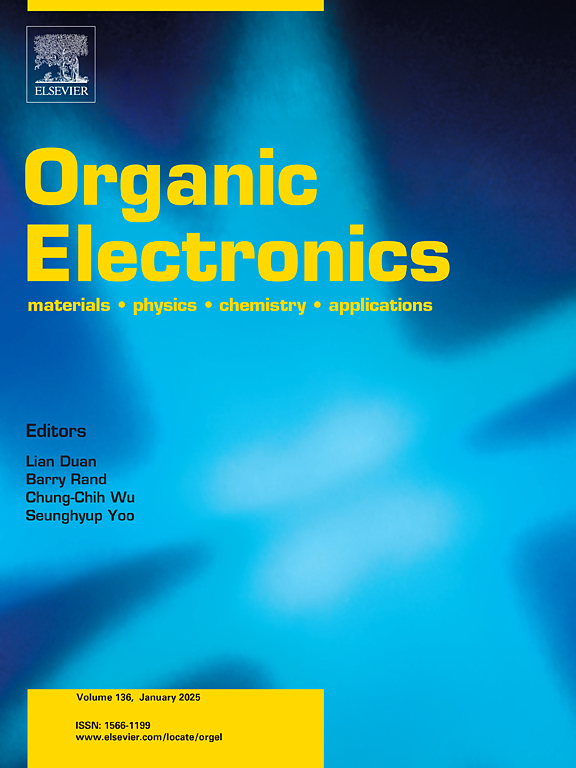Navigating the relationship between voltage losses and efficiency in organic solar cells
IF 2.6
4区 工程技术
Q3 MATERIALS SCIENCE, MULTIDISCIPLINARY
引用次数: 0
Abstract
In recent years, organic solar cells (OSCs) have made significant progress, with power conversion efficiencies over 20 %, mainly due to advances in non-fullerene acceptors. Nevertheless, high voltage losses— especially those caused by non-radiative recombination — remain a major obstacle to further efficiency improvements. In contrast to traditional fullerene-based OSCs, state-of-the-art non-fullerene OSCs enable efficient charge generation and extraction even at small energy offsets (<0.3 eV) between the HOMO levels of the donor and the acceptor materials (ΔHOMO). However, achieving low voltage loss while maintaining high fill factor and short-circuit current (Jsc) is a major challenge due to inherent trade-offs. In this study, we systematically investigate the relationship between voltage losses and the other two parameters in nine non-fullerene OSC devices with ΔHOMO in the range of about 0–0.5 eV. Both radiative and non-radiative voltage losses show a clear increase with ΔHOMO. However, no general correlation was found between the voltage loss, Jsc and FF. Only poorly performing IDTBR-based devices show clear increase of Jsc with ΔHOMO, which, according to the transient absorption data, is caused by inefficient charge generation at low ΔHOMO attributable to high exciton binding energy or inferior molecule packing. At the same time, the opposite trend is observed for well-performing blends. These features suggest that variations of other blend parameters rather ΔHOMO cause variations of Jsc and FF overwhelming dependence on ΔHOMO.

有机太阳能电池中电压损失与效率之间的关系
近年来,有机太阳能电池(OSCs)取得了重大进展,功率转换效率超过20%,这主要是由于非富勒烯受体的进步。然而,高电压损耗——特别是由非辐射复合引起的高电压损耗——仍然是进一步提高效率的主要障碍。与传统的富勒烯基OSCs相比,最先进的非富勒烯OSCs即使在供体和受体材料HOMO能级之间的小能量偏移(<0.3 eV)下也能高效地产生和提取电荷(ΔHOMO)。然而,由于固有的权衡,在保持高填充因子和短路电流(Jsc)的同时实现低电压损耗是一项重大挑战。在这项研究中,我们系统地研究了在0-0.5 eV范围内,ΔHOMO的9个非富勒烯OSC器件中电压损失与其他两个参数的关系。随着ΔHOMO的增大,辐射和非辐射电压损耗均明显增加。然而,电压损失、Jsc和FF之间没有普遍的相关性。只有性能较差的基于idtbr的器件的Jsc在ΔHOMO处有明显的增加,根据瞬态吸收数据,这是由于高激子结合能或较差的分子包装导致的低ΔHOMO处电荷产生效率低下造成的。同时,对于性能良好的共混物,观察到相反的趋势。这些特征表明,其他混合参数的变化而不是ΔHOMO导致Jsc和FF的变化对ΔHOMO的压倒性依赖。
本文章由计算机程序翻译,如有差异,请以英文原文为准。
求助全文
约1分钟内获得全文
求助全文
来源期刊

Organic Electronics
工程技术-材料科学:综合
CiteScore
6.60
自引率
6.20%
发文量
238
审稿时长
44 days
期刊介绍:
Organic Electronics is a journal whose primary interdisciplinary focus is on materials and phenomena related to organic devices such as light emitting diodes, thin film transistors, photovoltaic cells, sensors, memories, etc.
Papers suitable for publication in this journal cover such topics as photoconductive and electronic properties of organic materials, thin film structures and characterization in the context of organic devices, charge and exciton transport, organic electronic and optoelectronic devices.
 求助内容:
求助内容: 应助结果提醒方式:
应助结果提醒方式:


